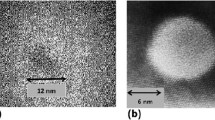Abstract
The problem of reconstructing the light-impurity concentration profile in a heavy matrix in the method of resonance nuclear reactions is considered. The principal physical and experimental factors affecting the shape of the yield curve in this method are discussed in detail. An integral equation is derived by taking account of the energy spread of the initial ion beam, the energy-loss straggling, the width and shape of the resonance, and the influence of the Doppler effect. A package of programs is developed for solving this equation by using the Tikhonov regularization method, which makes it possible to correctly take into account the error in the experimental determination of the yield as well as the approximate nature of the model used to describe the interaction of the ion beam with matter. The concentration profile of oxygen ions implanted with an energy of 150 keV into a silicon single crystal is reconstructed and the effect of resonant laser radiation on diffusion in such a system is studied.
Similar content being viewed by others
Literature cited
V. E. Storizhko, Nuclear Microanalysis. A Review [in Russian], TsNIIatominform, Moscow (1986).
A. N. Tikhonov and V. Ya. Arsenin, Methods of Solving Ill-Posed Problems [in Russian], 3rd revised edn., Nauka, Moscow (1986).
B. Maurel, G. Amsel, and G. P. Nadai, Nucl. Instrum. Methods,197, 1 (1982).
I. Vickridge and G. Amsel, Nucl. Instrum. Methods,B45, 6 (1990).
G. Amsel and I. Vickridge, Nucl. Instrum. Methods,B45, 12 (1990).
M. A. Chaudhri and C. W. Chittleborough, Nucl. Instrum. Methods,197, 37 (1982).
B. K. Patnaik, C. V. Barros-Leite, G. P. Baptista, et al., Nucl. Instrum. Methods,B35, 159 (1988).
V. S. Remizovich, D. B. Rogozkin, and M. I. Ryazanov, Fluctuations of Ranges of Charged Particles [in Russian], Énergoatomizdat, Moscow (1988).
A. Rotondi and P. Montagna, Nucl. Instrum. Methods,B47, 215 (1990).
J. F. Ziegler, J. P. Biersak, and U. Littmark, Stopping Powers and Ranges of Ions in Matter, Vol. 1, Pergamon Press, New York (1985).
A. F. Lubchenko and V. N. Pavlovich, Phys. Status Solidi B,78, K97 (1976).
V. G. Artsimovich, I. F. Mogil'nik, V. N. Pavlovich, et al., Papers Read at Third All-Union Conference on Ion-Beam Microanalysis [in Russian], Sumy (1991).
M. V. Artsimovich, A. I. Baranov, S. D. Zotov, et al., Proceedings of Twenty-First All-Union Conference on the Physics of the Interaction of Charged Particles with Crystals [in Russian], Izd. Mosk. Gos. Univ., Moscow (1992).
Additional information
Institute of Applied Physics, Academy of Sciences of the Ukraine. Translated from Izvestiya Vysshikh Uchebnykh Zavedenii, Fizika, No. 5, pp. 79–86, May, 1993.
Rights and permissions
About this article
Cite this article
Zabashta, O.I., Kul'ment'ev, A.I. & Storizhko, V.E. Depth profiling of light impurities by the method of resonance nuclear reactions. Russ Phys J 36, 484–489 (1993). https://doi.org/10.1007/BF00560429
Received:
Issue Date:
DOI: https://doi.org/10.1007/BF00560429




